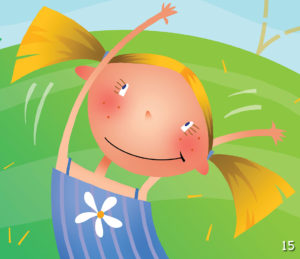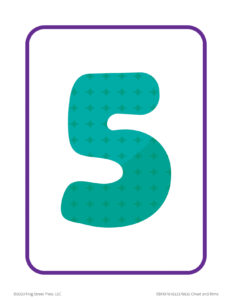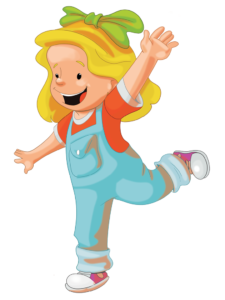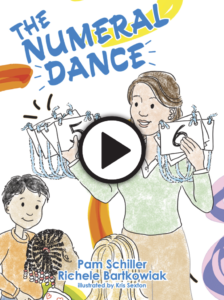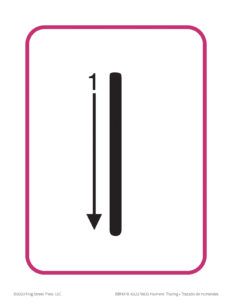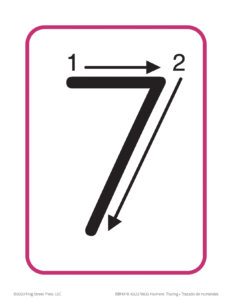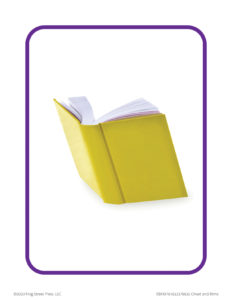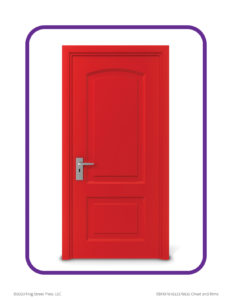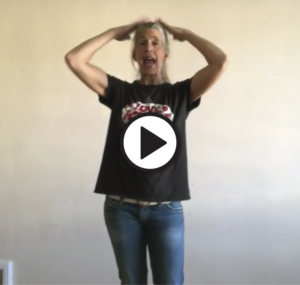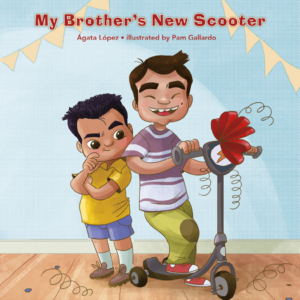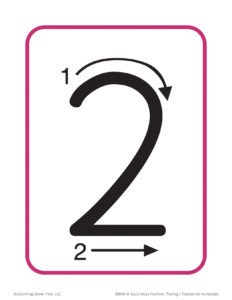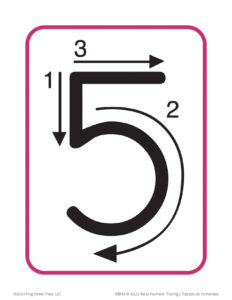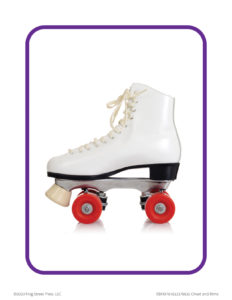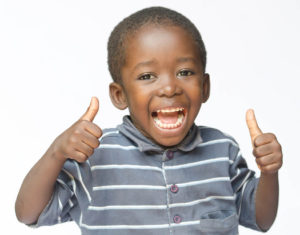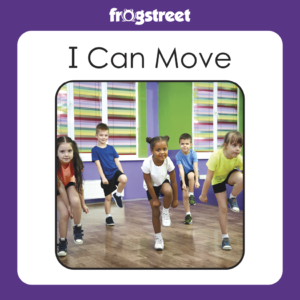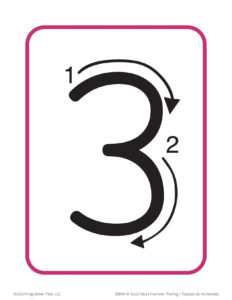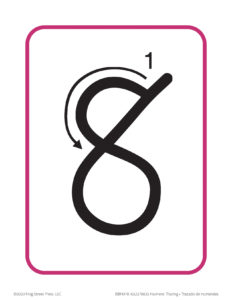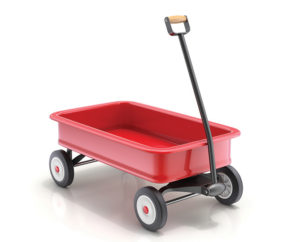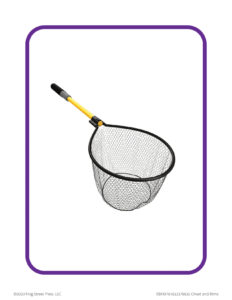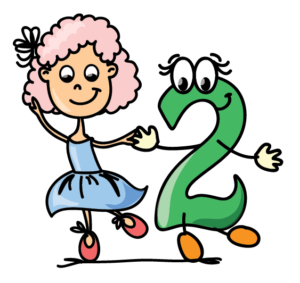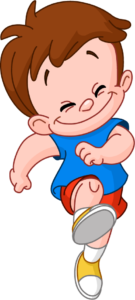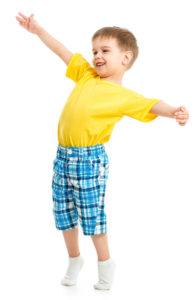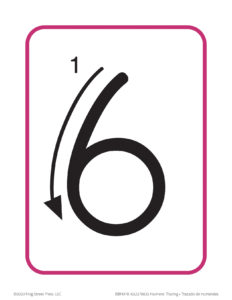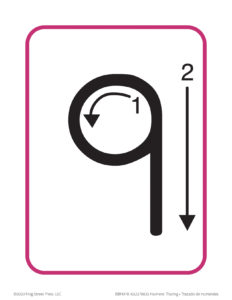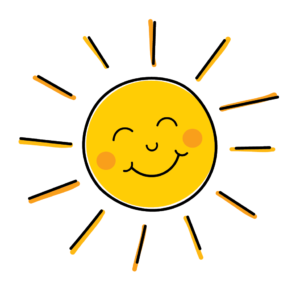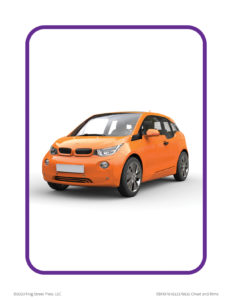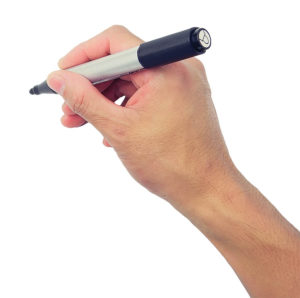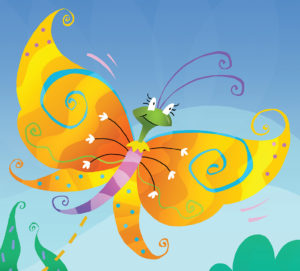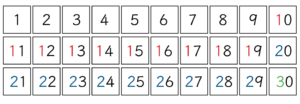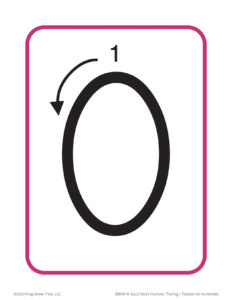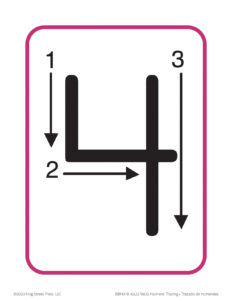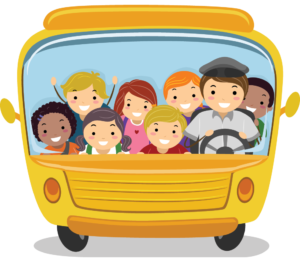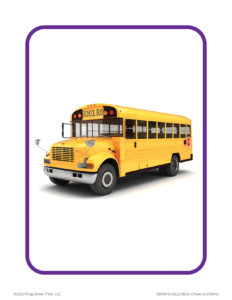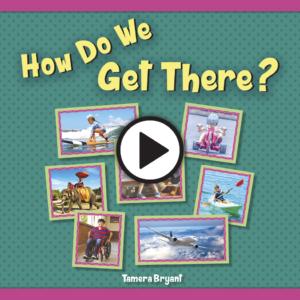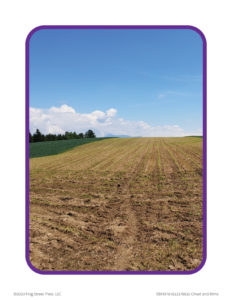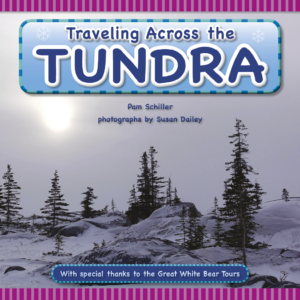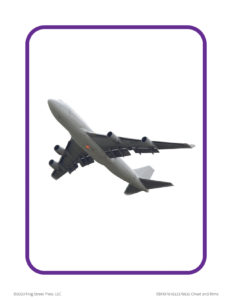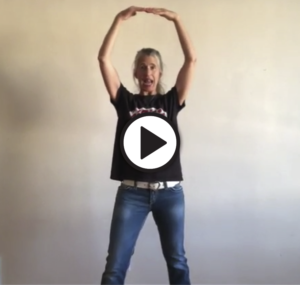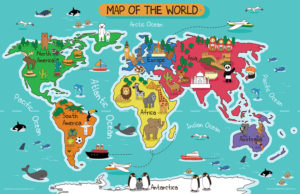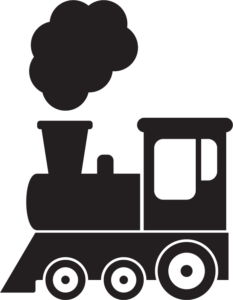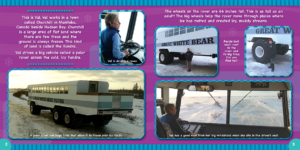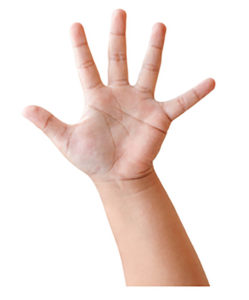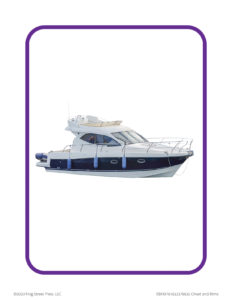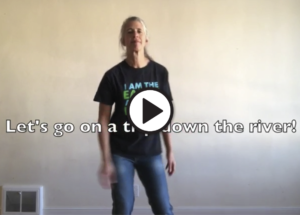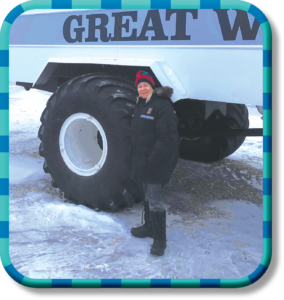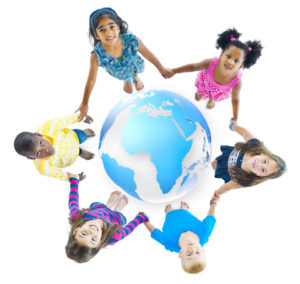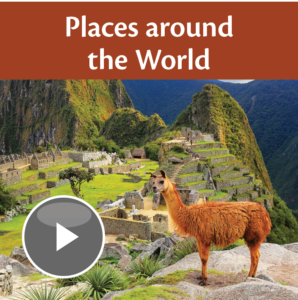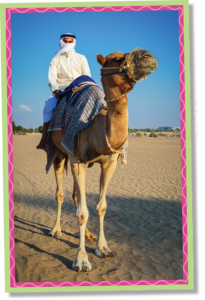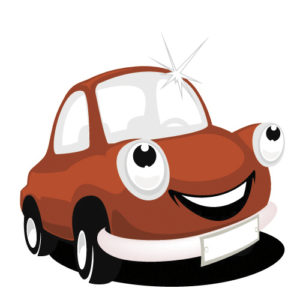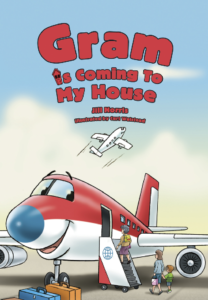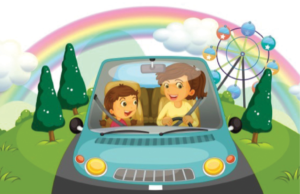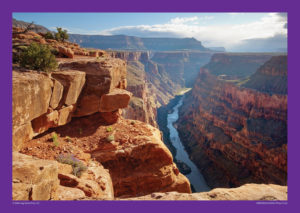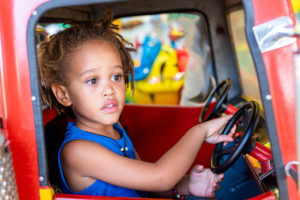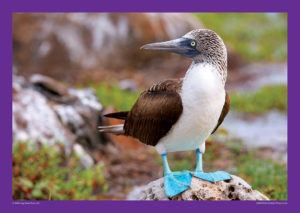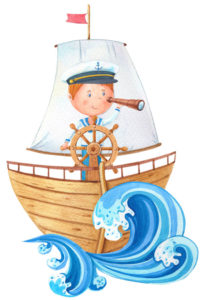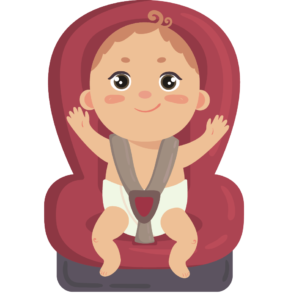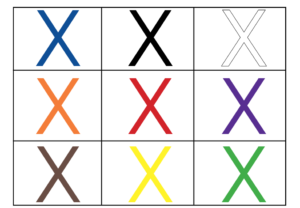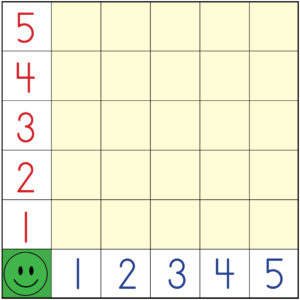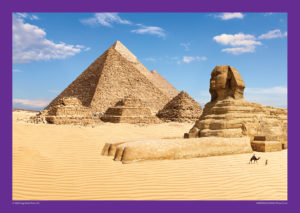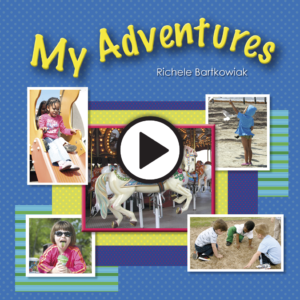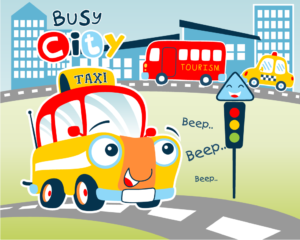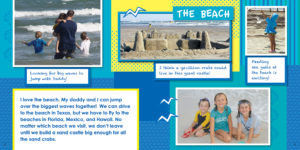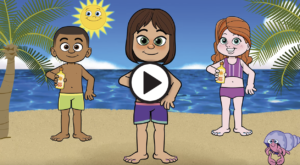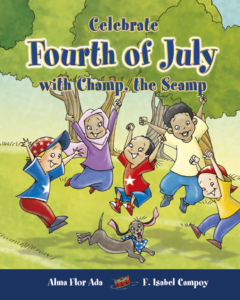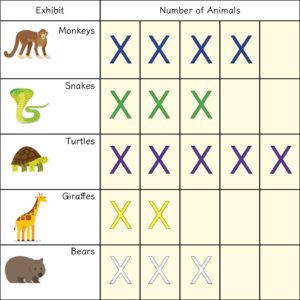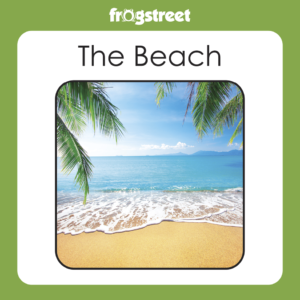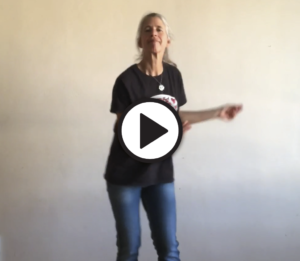On the Move
Week 1: I Move
This week, your child will explore ways to move. She will learn about the idea of personal space. Your child will think about giving others the space they need.
Word of the Week: maneuver
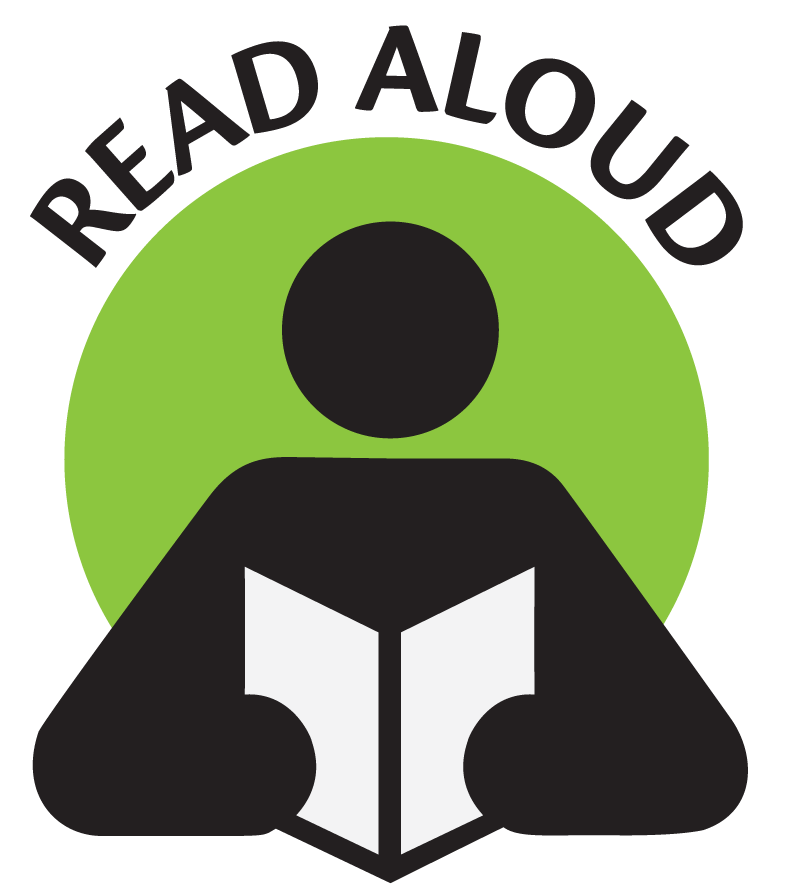
Books to Read
- I Can Move eBook
- My Brother’s New Scooter eBook
- The Numeral Dance eBook
- The Numeral Dance Read-Aloud video
Supplies to Gather
- crepe paper streamers
- feather
- homemade dot cards from previous week
- index cards, paper squares, or stick-on notes
- journal
- lotion
- paper
- paper plate spinner: paper plate, paper clip, pencil
- several toys with wheels
- socks
- tennis shoes
- writing tools
Daily Message
I can dance beside a friend. Can you?
- Say the sentences. Have your child repeat them.
- This week your child will practice blending sounds to make a word.
- Say the first sound in “dance” /d/. Say the rest of the word /ance/. Have your child blend the sounds /d/ and /ance/ to say “dance.”
- Practice blending more sounds. Click image to get started.
Storytime
Watch The Numeral Dance Read-Aloud video. Help your child understand unfamiliar action words such as revvin’, squirm, and shimmy. Do each of the moves together. Ask: What happens when you are not in control of your moves? Do you think the children in the story were in control of their moves? Why or why not?
Dig 1 to 10
This week, practice counting in sets of 10 (decades). Write numerals 1-10 on separate index cards, paper squares, or stick-on notes. Make a straight path of the cards on the floor. Starting at 1, have your child pretend to dig (push down, pull up) each numeral while saying it and moving along the path. Have your child clap once when she reaches 10. (Save numeral cards to use again.)
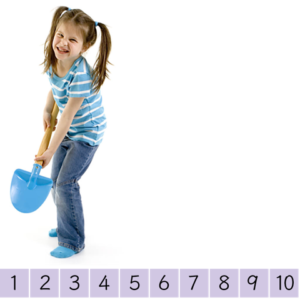
Write 1 and 7
This week, your child will practice writing two numerals each day. To begin, use two fingers to draw a numeral on your child’s back. Talk about the lines in the numeral. Next, have your child write the numeral on paper. Repeat for the second numeral. Click image for instructions to write numerals.
Body Moves
Make a paper plate spinner with four equal sections labeled “jump,” “skip,” “bend knees,” and “flap arms.” Hold a paper clip in place at the center of the plate using a pencil tip. Invite your child to mix up the stack of 0-5 dot cards she made last week. Remove a card from the deck. Have your child spin the spinner and do that many exercises.
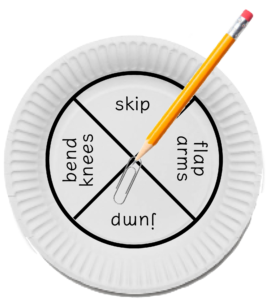
Draw to Music
Give your child a large sheet of paper and several markers. Play instrumental music. Have your child close his eyes and focus only on the music for a few seconds. Then have him draw to the music. Ask: How did you feel while you were drawing? How did the music help you decide what to draw?
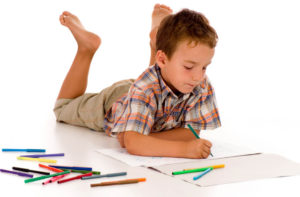
Pretzel Bend
Try this new version of Pretzel Breathing. Have your child cross her arms and legs as if doing the Pretzel. Say: Take a deep breath in through your nose. Exhale as you slowly bend at your waist. Inhale as you stand up. Exhale and bend again. Repeat the exercise three times.
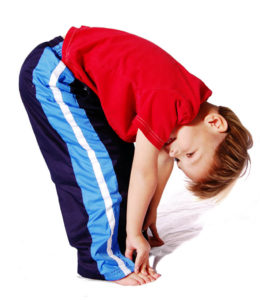
Head to Toes
Sing along and do the motions for this version of “Head, Shoulders, Knees and Toes.” Ask: What does it mean when the song says the head is for “yes-ing” and “no-ing”? What would you say your toes are for?
Storytime
Show the cover of My Brother’s New Scooter and read the title. Ask: How do you think the boys are feeling? What can you tell by the expressions on their faces? Read the story. Explain any unfamiliar words. When you are finished reading, ask: Were you surprised by the ending? Did Miguel ride Juan’s scooter in real life or in his dreams?
Teeter 11 to 20
Write numerals 11-20 on separate index cards, paper squares, or stick-on notes. Make a straight path of the cards on the floor. Starting at 11, have your child teeter (tiptoe with arms out to sides) along each numeral while saying its name. Have your child clap two times when she reaches 20. (Save the cards.)
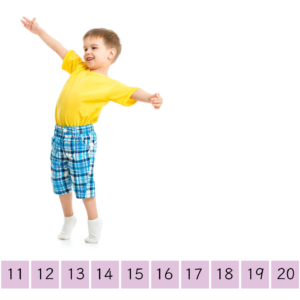
Nature Moves
While your child is playing outdoors, talk about how trees, flowers, clouds, and leaves move when the wind blows. Point out how leaves on trees shake, small trees bend, clouds move overhead, flowers sway, and fallen leaves tumble and swoop up and down. Invite your child to demonstrate each of these movements.
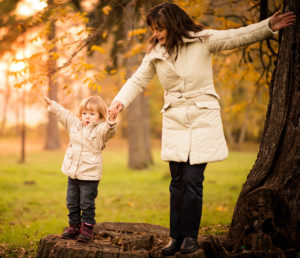
Copy Me
Say: Your body can move in many different ways. Play a “Copy Me” game. Bend a finger and have your child copy the move. Stand on one foot and swing the other leg. Repeat with other body parts and more challenging moves. Give your child a chance to be the leader and model moves for you to copy.
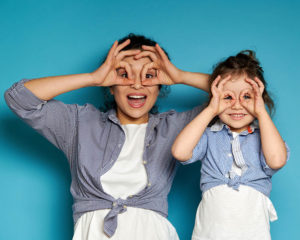
Personal Space
Stand with your child. Extend your arms out to each side. Turn slowly around. Explain that this arm’s length turn defines your personal space. Have your child show you his personal space. Say: This is how much space we should give others when we are moving around. Respecting personal space keeps us from bumping into each other.
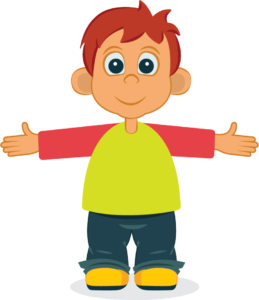
Writing Together
Share one way that you like to move. Write your idea on a paper completing the sentence: I can __________ . Have your child share a way he likes to move. Write your child’s idea on the paper. Add your names after your answers. Track your hand under the words as you have your child “read” his response. Ask: Why do some words begin with an uppercase letter?
I can skate. (Mom)
I can hop on one foot. (Carly)
Storytime
Show the cover of I Can Move. Read the title as you track the words.. Turn to the page titled “Picture-Supported Vocabulary.” Point to each photo. Ask your child to tell how the child is moving. Point to and read the word below each photo. Read the book with your child.
Twist 21 to 30
Write numerals 21-30 on separate index cards, paper squares, or stick-on notes. Make a straight path of the cards on the floor. Starting at 21, have your child twist along the path saying the name of each numeral. Have your child clap three times when she reaches 30. (Save the cards.)
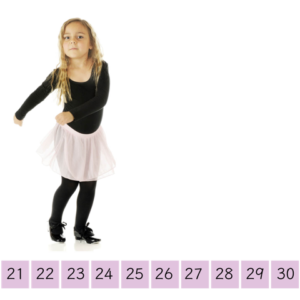
Moving Is Good!
Walk, run, skip or hop along a path or sidewalk with your child. Explore toys that help you both move as you roller skate, ride a scooter, or pull a wagon. Point out that these fun activities are good exercise.

Touch and Move
Have your child sit very still. Explain that you will touch her with a feather or finger. Your child will move only the body part you touch. For example, you touch your child’s pinky finger. Your child moves her pinky. Give your child a chance to be the “toucher.”
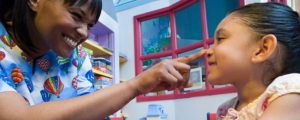
My Journal
Read I Can Move with your child. Encourage your child to identify each picture and then repeat the words with you. Have your child draw a picture in her journal to complete the sentence: I can __________ . If your child is ready, suggest she copy the words below her drawing.
Storytime
Listen to The Numeral Dance Read-Aloud video. Many of the actions in the story don’t move you from one place to another. For example, ask: Will wiggling your arms move you from here to there? Think of actions that do move across the room. Use these actions to make your own dance. Click image to get started!
Dance the Decades
Place the numeral cards 1-30 in three rows on the floor: 1-10 in row one, 11-20 in row two, and 21-30 in row three. Have your child combine the moves she did each day to “dance the decades.” (Dig for 1-9, clap once on 10; tiptoe for 11-19, clap twice on 20; twist for 21-29, clap three times on 30.) Click image to see the counting sequence.
Friction
Have your child slide across an uncarpeted floor wearing tennis shoes. Have her take off the shoes and try again, wearing just socks. Ask: Was it easier to slide in tennis shoes or in socks? Why? Show your child the grooves on the bottom of the shoes. Explain that the rubber grooves create friction (resistance) between the floor and the shoe. That makes it hard to slide.
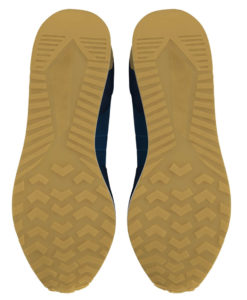
Streamer Maze
Stretch crepe paper streamers across an open space. Place some streamers low enough for your child to step over them. Raise others high enough to wiggle under. Have your child maneuver the course (crawling, walking) without touching any streamers.
Safety Note: Never use string or rope for this course. Only use paper streamers that will easily tear to avoid injury.
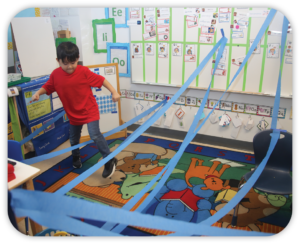
Writing Letters
Focus Letters: Aa, Bb, Cc
Review how to write the letters. Have your child watch as you write a letter saying the strokes. Have your child write the letter with a finger on the floor repeating the strokes. Then have your child practice writing on paper. Repeat for each letter. Click image for letter formation directions.
Show the Moves
“Can You Move with Me?” is filled with great movement words! (wiggle, squiggle, squirm, flutter, fly, crawl, flip, flop, hop, slither, shake, dance) Have your child show each move. Help with any that are unfamiliar. Ask: Which one is your favorite? Why? Share your favorite too. Sing and move! Click image for lyrics.
Storytime
A setting of a story is the place where the action happens. The main character is the person who is the focus of the story. Read My Brother’s New Scooter. Have your child tell the main character (Miguel) and the setting (neighborhood). Ask: How would the story have been different if Juan had let Miguel ride his scooter at the beginning of the story?
Tire Treads
Have your child look at the tire treads (grooves) on a car or bike. Compare the grooves on the tire to those on the bottom of a tennis shoe. Ask: How are they alike? different? Explain that the grooves on tires cause friction on the surface of the street and keep the car or bike from skidding when it stops.
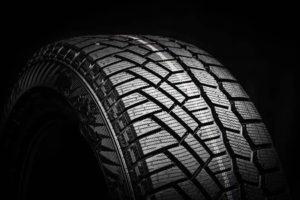
Rub, Rub, Rub
Have your child rub his hands together quickly for 30 seconds. Ask: How do your hands feel? Why did they get warmer as you rubbed? Explain that the friction caused by rubbing hands together causes heat. Place lotion on your child’s hands. Have him rub his hands together again. Ask: How does lotion change the way your hands feel? (slick, not as much friction or heat)
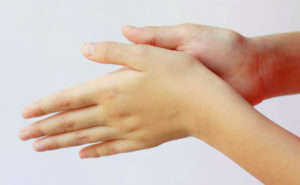
On the Move
Week 2: Transportation
This week, your child will learn about land, air, and water travel. You will talk about many different kinds of transportation.
Word of the Week: transportation
Before You Begin
Watch these videos to better understand the concepts your child will be learning this week. These are not videos you will watch with your child. These are just for you!

Books to Read
- How Do We Get There? eBook
- How Do We Get There? Read-Aloud video
- Traveling Across the Tundra eBook
Supplies to Gather
- boat: aluminum foil, bowl of water, paper clips
- box lid or take-out pizza box
- crayon without paper wrapper
- egg float: two jars, water, salt
- floating experiment: coin, paper clip, pebble, toothpick, pencil, plastic spoon, metal spoon, rock, ladle
- fly and fall experiment: lightweight objects, dishtowel or pillowcase
- journal
- measure big wheels: tape measure, scissors, string or yarn, tape
- paper
- sink the boat: container of water, lid of jar, pennies
- spoon and fork
- sticky dots
- writing tools
- yarn
Storytime
Watch the How Do We Get There? Read-Aloud video with your child. Encourage your child to participate with the reader. Talk about the many different ways to travel. Ask: What is one way you would like to travel? What is one way you would not like to travel? Why?
Train Cars
This week, you and your child will be looking for and making patterns. A pattern can be a sequence of pictures, motions, objects or colors that repeat the same way every time. Today, begin to notice things that are the same on a train’s cars. This will be a first step in seeing patterns. Click image to get started!
Traffic Light
When you are walking or driving along a street with your child, notice the changing colors on traffic lights. Talk about what each color means. Ask: What do cars do when the light is green? yellow? red? Point out how the colors change in a pattern (predictable sequence). Ask: What color will the signal change to after green? after yellow? after red?
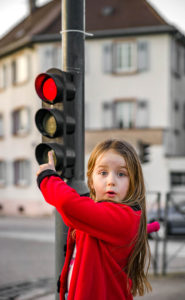
Will It Float?
Gather small objects including a coin, paper clip, pebble, toothpick, pencil, plastic spoon, and metal spoon. Have your child place one object at a time gently on the surface of water in a sink or tub. See what happens. Ask: Did it float? sink? Repeat with the next object. Ask: Why do you think some objects float and others sink?
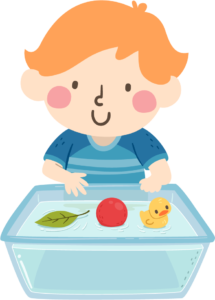
To and From
As you travel to and from the store or the park, look for different kinds of transportation. You might see cars, bicycles, buses, airplanes, and trains. Point out that walking is also a form of transportation. Count the different kinds. Ask: How many did we see? Were you surprised about how many (few) we saw? Why?

Train Breathing
Pretend to be a train with a heavy load. Take a deep breath as you raise your hands over your head going up a big hill. Slowly go over the peak of the hill. Lower your arms to your sides as you go down the other side. Exhale saying: Choo, choo, choo, choo. Continue up and over three big hills.
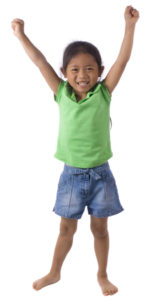
Put Them Together
Say this chant for your child:
My word begins with /b/
and ends with /us/.
Put them together
And the word is bus!
Repeat the chant using other transportation words. (Remember to say the sounds of the letters not the letter names.) Pause at the end of the chant so your child can say the blended word.
j-et
b-oat
sl-ed
c-amel
l-imo
Fly and Fall
Help your child make lightweight objects fly and fall. Have your child hold two corners of a dish towel or pillowcase. Hold the opposite corners yourself. Place an object in the center. Together lift your arms high over your heads and lower them. Talk about how the towel lifts the objects into the air. Ask: Why does the object fall back down instead of flying away?

Storytime
Show the cover of Traveling Across the Tundra. Read the title. Say: Tundra is a large area of flat land where there are few trees and the ground is always frozen. It is difficult to drive over this land because it is slippery and slushy. Have your child listen carefully as you read to find out what vehicle can travel across the tundra.
Go, Slow, Stop
Use markers to draw a traffic light. Ask your child where each color goes. Ask: Which color goes at the bottom? in the middle? on top? Invite your child to do different moves as you point to each color: Run in place for green, walk slow for yellow, freeze for red. Repeat the traffic light “dance” three times.
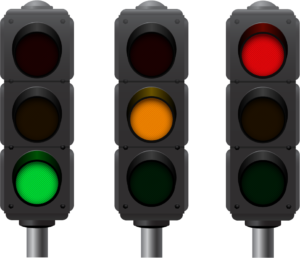
Sink or Float?
Repeat the experiment from Day 1. Talk about why only some things float. Choose a large object (rock) and a small object (pebble). Ask: What difference does size make? Use objects made of different materials (plastic spoon, metal spoon). What difference does the material make? Try new objects. Predict whether they will sink or float before testing.
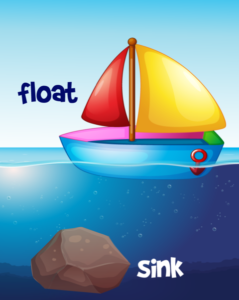
Parking Garage
Use a box lid or take-out pizza box to make a parking garage for toy vehicles. Draw the parking spaces on the cardboard and number them. Use sticky dots to number the toy vehicles. Have your child park each vehicle in its correct spot (matching numeral) in the garage.
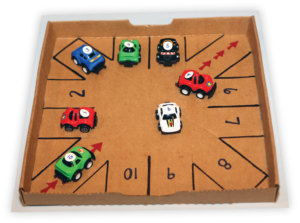
Writing Together
Play a question-answer game to make a list of ways to travel. You give the clues. Have your child say the answer. For example, say: I need to go to the grocery store. How should I travel? Write the name of the place and your child’s answer beside it. Repeat with more destinations. Keep the list for tomorrow’s writing activity.
Place
grocery store
Hawaii
across a river
Transportation
car
airplane
boat
Amazing Rocket Ship
Watch the musical story “Amazing Rocket Ship.” Ask: What are some of the things the children in their amazing rocket ship did to save the day? Is this song about a real rocket ship or a pretend one? Why do you think that?
Storytime
Before reading, click image for map. Point to Hudson Bay on the map. Explain that the town in the book, Churchill, is by Hudson Bay. Find where you live on the map. Have your child trace a line with his finger from where you live to Hudson Bay. Read Traveling Across the Tundra.
Pattern Core
Have your child use markers to draw green, yellow, and red circles in a line. Ask: What comes after green? yellow? red? Have your child repeat the color sequence three times. Circle the first green-yellow-red set of circles. Say: These three colors repeat. We call this the
pattern core. Have your child circle the other green-yellow-red sets.

Big Wheels
Look at pages 2-3 in Traveling Across the Tundra. Point to the polar rover’s wheel. Use a tape measure and scissors to cut string or yarn the height of the wheel (66 inches). Tape the yarn to the wall. Have your child stand next to it. Compare the heights. Ask: Are you taller than a rover wheel? shorter? How do you know?
Bus Ride
If there is a public bus in your community, take your child for a ride. As other passengers get on the bus, point out how they scan their tickets and take a seat. Enjoy the sights as you look out the windows.
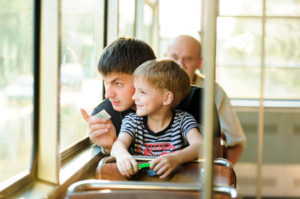
My Journal
Show the list of places and ways to travel that you created yesterday. Track the words with your hand as you and your child “read” it. Have your child illustrate her favorite way to travel on the first blank of page of her journal. Help to label the drawing.

Row Your Boat
Watch the video “Row, Row, Row Your Boat” as you go on a boat adventure today. Follow the directions and join in the action. When the boat ride is over, ask: How would you describe the ride? Was it gentle or wild? Where do you think the boat stops?
Storytime
Watch the How Do We Get There? Read-Aloud video with your child. Ask: What types of transportation were new to you? Which types of transportation in the story have you used?
Design a Train
Draw a train car with four boxes. Have your child use blue, yellow, and red markers to color in the boxes using “rules” called design criteria:
- The train car must have three colors.
- Two side-by-side boxes must be the same color.
This will be the “pattern core” for the train. Have your child “read” the pattern core (name each color in order from left to right).

Egg Float Test
Fill two jars with water. Add three tablespoons of salt to one of the jars. Stir. Invite your child to place an egg inside each jar. Ask: What happens? Are the eggs the same? Is the water the same? Which water has the floating egg? Say: Salt added to water helps to support the egg.
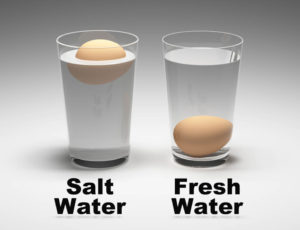
“Read” a Pattern
Place a spoon on the table. Then place a fork next to it. This will be your pattern core: spoon-fork. Continue adding spoons and forks as you repeat the core three times. Point to and name the objects: spoon-fork-spoon-fork-spoon-fork-spoon-fork. This is called “reading” a pattern. Help your child create and “read” another pattern.
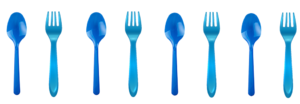
Boat Maker
Try making a boat with your child. Mold a small square of aluminum foil in the shape of a flat-bottomed nest. Carefully place the “boat” in a bowl of water. Ask: Does it float? Will it still float if you put a few small objects like paper clips inside? How would you make a stronger boat?
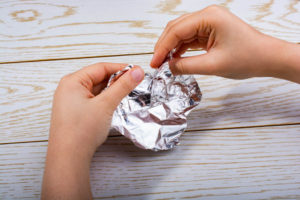
Safe in the Car
Talk with your child about practices that keep your family safe in a car. Say: Show me what it looks like and sounds like when you are helping keep our family safe in a car. Offer ideas, such as keeping hands in own space, wearing seat belt, and talking quietly.
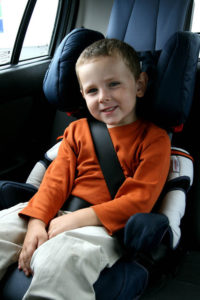
Writing Letters
Focus Letters: Dd, Ee, Ff
Review how to write the letters. Have your child watch as you write a letter saying the strokes. Have your child write the letter with a finger on the floor repeating the strokes. Then have your child practice writing on paper. Repeat for each letter. Click image for letter formation directions.
Wheels on the Bus
Sing along with this traditional version of “The Wheels on the Bus.” Have your child suggest new verses. For example, you might ask: What do you think the daddy on the bus would do? How do the brakes sound? Use your child’s words to create a new verse and sing it! Click image for song lyrics.
Storytime
Read How Do We Get There? with your child. Pause for your child to say the second word in the rhyming couplets:
You might cross the country in a hot-air balloon.
Or if you’re an astronaut, fly to the __________ . (moon)
My Pattern Train
Have your child use the train car she designed yesterday to create a train with at least four cars. Draw the framework for the train. Have your child color in the boxes (or your child may choose to do all the drawing herself). Have your child tell about her pattern.

Tire Patterns
Invite your child to walk with you outdoors. Look at tires on some ride-on toys. Have your child place a sheet of paper on top of a tire and rub a peeled crayon over the paper. The grooves (treads) of the tire will appear. Ask: Do you see a pattern in the tire markings? Have your child tell about the pattern.
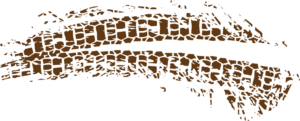
Tire Circumference
Look again at the giant rover tire on page 3 in Traveling Across the Tundra. Explain that the distance around the outside of the tire (circumference) is about 17 feet. Measure and cut a 17-foot piece of yarn. Make a circle with it. Invite your child to estimate how many pillows will fit inside.
Sink the Boat
Fill a container with water. Have your child place a jar lid on the surface so that the rim around it is facing up. Ask: Does it float? sink? why? Have your child place pennies (one at a time) inside the “boat” until it sinks. Ask: How many pennies did it take to sink the boat?
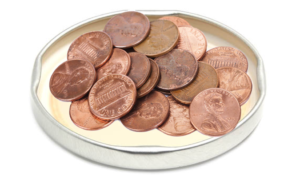
On the Move
Week 3: Travel
Last week, your child learned that transportation is a way of traveling from one place to another place. This week, you will talk about faraway places. Your child will learn about destinations on all seven continents.
Word of the Week: destination
Before You Begin
Watch these videos to better understand the concepts your child will be learning this week. These are not videos you will watch with your child. These are just for you!

Songs to Sing

Books to Read
- Gram Is Coming to My House eBook
- Places Around the World Video eBook
Supplies to Gather
- craft sticks
- journal
- map
- masking tape
- note cards or same-sized rectangles of paper
- paper
- paper squares or stick-on notes
- paper clip
- penny
- play dough
- small rocks or blocks
- small tote bag
- toothpicks
- writing tools
Daily Message
We can travel to a destination.
- As you say the sentence, draw one line on paper for each word. Make the line long for a long word and short for a short word.
- Write a word on each line as your child repeats the sentence. Ask: Why is the line for the word “can” shorter than the line for the word “destination?”
- Clap for each syllable as you say “des-ti-na-tion” (4). Clap for each syllable as you say “can” (1).
Storytime
Click world map image to introduce to your child the seven continents. Then watch the Places Around the World Video e-Book. The video introduces faraway destinations on all seven continents.
2-by-2 Grid
Have your child cross two craft sticks on top of a square sheet of paper to make a 2-by-2 grid. Give your child directions to place four different crayons on the grid. Say:
- Place red inside the top left square.
- Place blue inside the top right square.
- Place yellow inside the bottom left square.
- Place green inside the bottom right square.
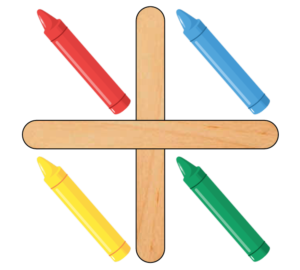
Numeral Train 1-10
Write the numerals 1-10 on paper squares. (You will be using these cards throughout the week.) Draw an engine (facing left) on another card. Mix up the cards. Place the engine on a tabletop. Have your child arrange the “cars” (numeral cards) in order.

Square Dance
Show your child how to dance in a square. Stand next to your child and have her copy your steps. Say: Jump forward one jump. Scoot to the right one scoot. Jump backward one jump. Scoot to the left one scoot. Repeat this sequence three more times. Ask: Why do we always end at the same place we started?
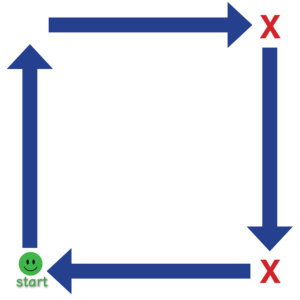
Map Your Yard
Work with your child to draw a simple map of your yard. Begin with an outline of your yard shape. Add features (table, swing, sandbox, flowerpot, bench, tree). Look at the finished map and point to a spot near one of the features. Have your child go to that spot in the yard. Say: Great job of reading the map!
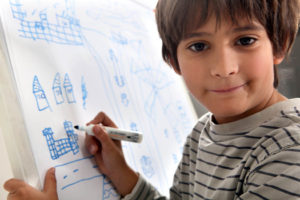
Bicycle Breathing
Have your child lie down on her back with plenty of space around for leg movement. Have her pretend to ride a bicycle by lifting her legs in the air and pedaling her feet. Have your child pedal slowly as she takes a deep breath in and then exhales slowly. Alternate pedaling fast and slow pedaling with deep breathing.
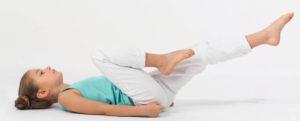
Daily Message
I pack a suitcase for my trip.
- As you say the sentence, draw one line on paper for each word. Make the line long for a long word and short for a short word.
- Write a word on each line as your child repeats the sentence. Ask: Why is the line for the word “pack” shorter than the line for the word “suitcase?”
- Clap for each syllable as you say “suit-case” (2). Clap for each syllable as you say “pack” (1).
Storytime
Read Gram Is Coming to My House. After reading, have your child remember the kinds of transportation Gram used. Ask: Which type of transportation was the fastest? How do you know? Ask: Who might come visit you? Would they need more than one kind of transportation?
Does It Match?
Fold paper into four equal sections to make a 2-by-2 grid. Draw along the folds with a marker. Make one grid for your child and one for you. Hide your grid from your child. Place a penny in one of your squares. Give your child a penny to place on his grid. Compare grids. Ask: Where is your penny? Where is mine? Continue until you get a match. Click image to see an example.
Numeral Train 1-20
Write the numerals 11-20 on paper squares. Mix up the cards. Have your child place these numerals in order to add train “cars” to the 1-10 train you created yesterday. The train will now be a long 20-car train.

Square Pattern
Do the square dance you learned yesterday. Use masking tape to mark off the corners of the square on the floor to help your child see where to stop after each move. After you dance, draw arrows on a strip of paper to represent a drawing of the dance pattern. Click image to see an example.
Top, Bottom, Middle
Have your child use the words top, bottom and middle. Look at the slide on the playground, the school building, or your neighbor’s house. Ask questions about the location of the parts: Is the roof at the top, the middle, or the bottom of the house? Where is the window? What about the front steps?
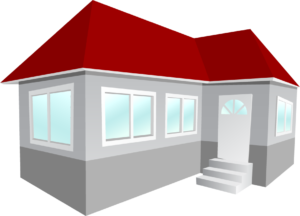
Daily Message
Gram took a gift for her grandson.
- As you say the sentence, draw one line on paper for each word. Make the line long for a long word and short for a short word.
- Write a word on each line as your child repeats the sentence.
- Say: /g/-/ift/. Have your child blend the sounds and say the “mystery” word. (gift)
- Have your child point to the punctuation mark at the end of the sentence.
Motoring
The song “Motoring” is about many different kinds of transportation. Listen to the song and see how many you can name (school bus, subway, planes, jumbo jet, trains). Ask: Would you like to transport people and things to their destinations? What kind of vehicle would you have? Click image for lyrics.
Storytime
Watch the Places Around the World Video e-Book. After watching, say: Each of the seven continents is home to different animals. Let’s talk about four interesting ones. Click bird image to get started!
3-by-3 Grid
Gather nine paper squares. Invite your child to make a row with three squares. Ask your child to point to the square in the middle, to the left and to the right. Tell your child to place a square above the middle square and one below it. Have your child complete the 3-by-3 grid by placing a square in each empty corner.
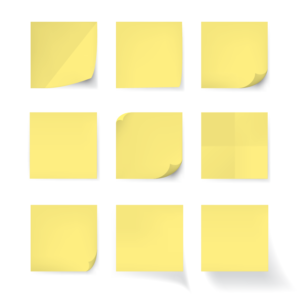
Numeral Train 1-30
Write the numerals 21-30 on paper squares. Mix up the cards. Have your child place these numerals in order to add train “cars” to the 1-20 train you created yesterday. The train will now be a long 30-car train.

Drop Test
Invite your child to hold a paper clip and a sheet of paper in opposite hands at the same height. Ask: If you let go at the same time, which item will reach the ground first? Why do you think so? Say “drop” as a signal to let go. Ask: Was your prediction correct? Why do you think it takes longer for the paper to reach the ground?
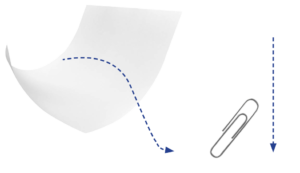
Looking for Maps
Look for maps in your community. Make a game of spotting them. You may find maps in a mall or library. Check at a train station or an airport. Notice the map on a GPS or app. Explain that a map is a special picture of a place. Talk about what it shows and why maps help us.

See the Sea
Teach your child the rhyme “A Sailor Went to Sea.” Point out that the words see and sea sound the same, but have different meanings. Do the hand suggested motions. This is also a great rhyme for clapping a simple hand jive (right hand to right hand, left hand to left hand). Click image to get started!
Daily Message
Many transportation vehicles have wheels.
- As you say the sentence, draw one line on paper for each word. Make the line long for a long word and short for a short word.
- Write a word on each line as your child repeats the sentence.
- Say/m/-/any/. Have your child blend the sounds and say the “mystery” word. (many) Repeat for /wh/-/eels/.
My Journal
Have your child imagine that she will visit a close relative or friend. Ask: What will you take as a gift? Show a small tote bag and explain that the gift must fit inside. Have your child draw her idea on the first blank page of her journal. Help your child label the drawing with the name of the gift.
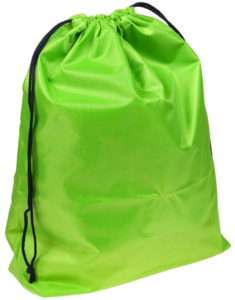
Storytime
Watch the Places Around the World Video e-Book. Focus today on faraway destinations that are “wonders.” The Grand Canyon and the Great Barrier Reef are natural wonders. They were made by nature. The Taj Mahal, Pyramids of Giza, Great Wall of China, and Machu Picchu are wonders made by people. Ask: Which wonder would you like to visit? Why?
Highest Count
Have your child pretend to be a rocket. Challenge him to count to the highest number he can while pretending to lift off into space. Ask: Can you count up to 10? 20? 30? higher? Offer help as needed.
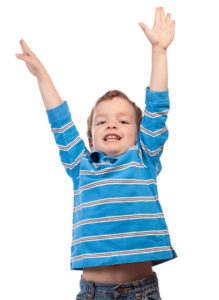
Paper Drop
Have your child hold a wad of paper and an uncrumpled sheet of paper in opposite hands at the same height. Ask: Which do you think will drop faster? Why? Have your child drop both at the same time. Ask: Was your prediction correct? Why? Why not? Explain that air pushes against the larger area of the uncrumpled sheet of paper causing it to fall slower.
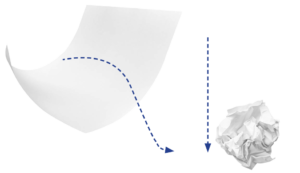
When I Travel
Have your child think of ways to help others as she travels. Whether going to school, running errands, or traveling to other destinations, your child can always take a S.T.A.R. breath, put a hand over her heart, and wish others well.
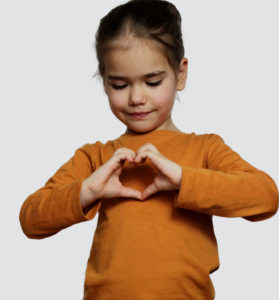
Daily Message
How do you travel to visit relatives?
- As you say the sentence, draw one line on paper for each word. Make the line long for a long word and short for a short word.
- Write a word on each line as your child repeats the sentence.
- Have your child answer the question. Write her answer below the sentence.
Letter Writing
Focus Letters: Gg, Hh, Ii
Review how to write the letters. Have your child watch as you write a letter saying the strokes. Have your child write the letter with a finger on the floor repeating the strokes. Then have your child practice writing on paper. Repeat for each letter. Click image for letter formation directions.
Storytime
Curt Walstead is the illustrator of Gram Is Coming to My House. As you read today, focus on the pictures. Ask: What is unusual about all of the vehicles? Why do you think Mr. Walstead gave them all faces? Turn to pages 22-23. Point to the taxi’s license plate. Say: Mr. Walstead gave the taxi a name—Justin. What would you name a vehicle?
Count Down 10 to 1
Invite your child to squat down on her knees and pretend to be a rocket about to blast off. Tell your child to start the countdown to blast off by counting backwards from 10. Have your child yell “Blast Off” and jump up into the air after the count of one.
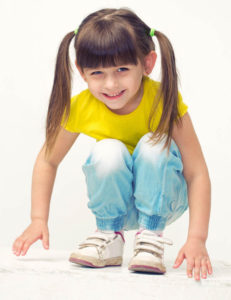
Going on a Trip
Plan a trip with your child. Find the destination on a map. Discuss how you will get there and what you will need to take with you. Note: A “trip” can be very simple. You can plan to visit Grandma, go the park, or even do an errand.
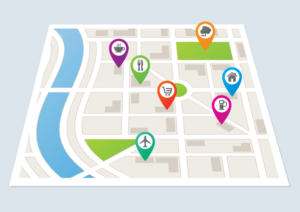
On the Move
Week 4: Places Kids Go
This week, your child will explore more travel. This travel will be about places that children especially like to go. Imagine adventures to the zoo, beach, children’s museum, and amusement parks as well as family outings, such as picnics.
Word of the Week: adventure
Before You Begin
Watch these videos to better understand the concepts your child will be learning this week. These are not videos you will watch with your child. These are just for you!

Books to Read
- My Adventures eBook
- My Adventures Read-Aloud video
- The Beach eBook
Supplies to Gather
- blue paper or hand towels
- clothespin toss: clothespins, bucket
- journal
- numbered 5-by-5 grid from previous week
- paper
- picnic: basket or bag, outdoor snack, blanket
- small animal toys: elephant, giraffe, alligator (change animals as needed)
- spinner: paper plate, pencil, paper clip
- writing tools
S.T.A.R.
Explain to your child that even when you travel to really fun places, some big feelings can show up when something happens that you don’t like. Remind your child about ways to handle big feelings. Your child can stop, take a deep breath, and relax. Sing “S.T.A.R.” while pretending to be on an adventure. Click image for lyrics.
Daily Message
My family takes joyful adventures!
- As you say the sentence, draw one line on paper for each word. Make the line long for a long word and short for a short word.
- Write a word on each line as your child repeats the sentence.
- Have your child notice and name the exclamation point at the end.
In the Middle
“Monkey in the Middle” is a follow-the-leader song. After watching and moving along with the video, gather family members. Have them stand in a circle. Choose one “monkey” to be in the middle. Have your family do their own moves as you listen to the song.
Storytime
This week’s read-aloud story is about a scrapbook. A scrapbook is a special book in which you can keep photographs, letters, and stories to help remember special times. Ask: Do you have a scrapbook? Listen to the My Adventures Read-Aloud video. Ask: Do you think My Adventures is a good name for this book?
Spin a Color
Create a 4-color spinner using a paper plate. Hold a paper clip in place in the center with a pencil. Label a 4-column chart with the same colors. Have your child flick the spinner. Make an x in the column with that color. Continue spinning until one column has exactly five marks. You have made a graph!
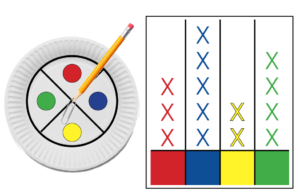
Question #1
Each day this week, your child will ask family members’ opinions about the best place to go for a family adventure. Today, your child will ask: Should we go somewhere quiet or loud? Write the question at the top of a sheet of paper and each family member’s name below. Mark that person’s response in the matching column next to their name.

Tally Chart
Decide on a question to ask members of your family or friends, such as: Do you like to travel by car, by bike, or by bus? Draw simple pictures to show three choices on a paper. Ask the question. Have your child draw a line (tally) next to the picture that matches each person’s answer. Ask: Which kind of travel do the most people like?
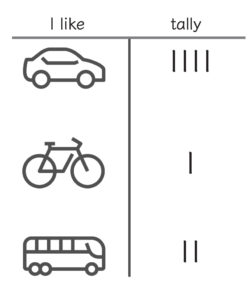
Celebrations
Families celebrate special occasions. Discuss your family’s celebrations. Ask: What holidays do you celebrate? Who is part of the celebration? Do you stay at home or do you travel somewhere? What foods and decorations are part of the celebration?

Daily Message
My family likes the meerkats at the zoo!
- As you say the sentence, draw one line on paper for each word. Make the line long for a long word and short for a short word.
- Write a word on each line as your child repeats the sentence.
- Have your child notice and name the exclamation point at the end.
Guess the Word
Review this chant with your child:
My word begins with /b/
and ends with /us/.
Put them together
And the word is bus!
Repeat using other words:
s-and
j-ump
b-each
c-astle
w-aves
Storytime
Show the cover of My Adventures. Point to the photographs and ask: What do you remember about each of these adventures? Talk with your child about her favorite adventure in the book. Turn to the pages about that adventure and read them. Explain that the little boxes tell specific information about the photo next to them. They are called captions.
Color Graph
Show your child the 4-column chart you made yesterday. Say: We made a graph. It is like a picture of what happened during the game. Have your child count the number of marks for each color. Ask: How many red? blue? green? yellow? Ask: Which color did you spin the most times? How do you know by looking on the graph?
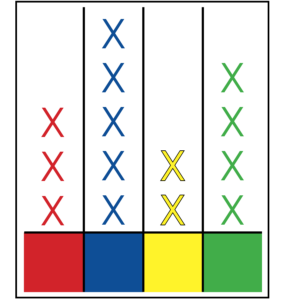
Question #2
Remind your child that this week you will be collecting information (data) about where your family would like to go on an adventure. Show the results of yesterday’s question. Today, have your child ask: Should the adventure be inside or outside? Make a new chart to record family answers.

Connect the Dots
Make a path of numbers on a sheet of paper. Put a dot beside each number. Have your child use a marker to connect the dots, starting at 0 moving in numerical order. Have your child tell the direction he will go to get to the next numeral. Ask: Will you go left? right? up? down? Click image to see a sample connect-the-dot path.
Animal Habitats
Encourage your child to build animal habitats. Ask: What animals will you have? Have your child think about ways to organize the habitats, such as by animal size, what the animals eat, or how much space they need. Remind your child that the animals need water and food. Ask: How does your habitat provide what animals need?
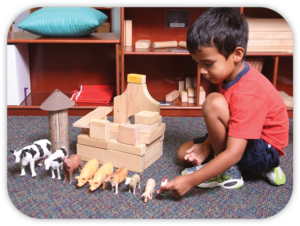
Daily Message
A baby kangaroo is called a joey.
- As you say the sentence, draw one line on paper for each word. Make the line long for a long word and short for a short word.
- Write a word on each line as your child repeats the sentence. Compare the length of two words.
- Have your child notice and name the period at the end.
Writing Together
Look at pages 8-9 in My Adventures. Have your child tell about favorite things at the beach. Write: I like __________ . Have your child share an idea to finish the sentence. Write his idea on the line. Add your idea in another sentence. “Read” the sentences together.
Sunscreen
Keep your skin safe on outdoor adventures by wearing sunscreen. This music video called “Sunscreen” reminds you to protect your skin. It also reviews body part names and is just great exercise. Join in and sing along!
Storytime
Show the cover of Celebrate Fourth of July with Champ, the Scamp. Remind your child that the Fourth of July is an important day. It is the birthday of the United States. Read the story. Ask: How were the children in the story planning to celebrate this important day? What do you do to celebrate the Fourth of July?
Clothespin Toss
Set up a “carnival” tossing booth. Mark a toss line and place a bucket about six feet away. Have your child toss seven clothespins (one at a time) toward the bucket. Draw a 2-column chart labeled “inside” and “outside.” After each toss, have your child place the clothespin in the column that tells where it landed. Save the chart for tomorrow.
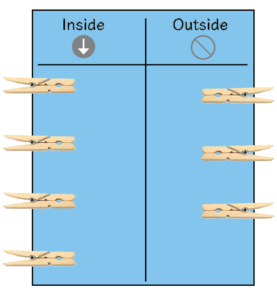
Question # 3
Show yesterday’s chart with the results of Question #2. Ask: Do most people want the adventure to be inside or outside? How do you know? For today, have your child ask: Should the adventure be somewhere far from or close to home? Make a new chart. Mark each person’s response in the column next to their name.

Row Together
As you sing “Row, Row, Row Your Boat” today, sit facing your child. Both of you will sit with legs folded and crossed with knees touching your partner’s knees. Hold hands and rock back and forth as you sing.
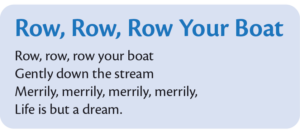
Daily Message
My sister likes the jellyfish.
- As you say the sentence, draw one line on paper for each word. Make the line long for a long word and short for a short word.
- Write a word on each line as your child repeats the sentence. Compare the length of two words.
- Say /s/-/ister/. Have your child blend the sounds and say the “mystery” word (sister).
My Journal
Read the sentences that you and your child wrote yesterday. Ask: What is the first word in each sentence? (I) Where is a word with four letters that begins with the letter l? (like) Read The Beach together. Have your child draw a picture to complete the sentence: I like __________ on the first blank page of her journal.
Are We There Yet?
Sometimes a road trip or even a trip to the store takes patience. Children often ask: Are we there yet? The song “Are We There Yet?” is about this familiar question. Listen to it together and then ask your child: How do you pass the time while you ride in the car? Click image for lyrics.
Storytime
Watch the My Adventures Read-Aloud video. Talk about all the ways you could keep memories of adventures. Ask: In what other ways could you save memories besides a scrapbook? (memory box, video, photos on corkboard, framed photo) What memory would you like to save?
Reading a Chart
Show the 2-column chart you made yesterday. Have your child count the number of clothespins in each category. Ask: Did you toss more clothespins inside or outside the bucket? How can you tell? Explain that when your child answers these questions she is getting information from the chart or “reading” it.

Question #4
Look at the chart showing yesterday’s results. Ask: Do most people want to go far away or stay close to home? How do you know? Today, have your child ask: Should we go during the daytime, at night, or both? Make a new chart. Mark each person’s response in the matching column next to their name.

Star Gazing
Plan an adventure for gazing at the night sky. (It will need to be a night with no clouds.) Have your child name objects she sees in the sky. Ask: Do you see any stars? Which star is the brightest? Do you see a full moon? half-moon? Point out star constellations that are easy for your child to recognize, such as the Big Dipper.
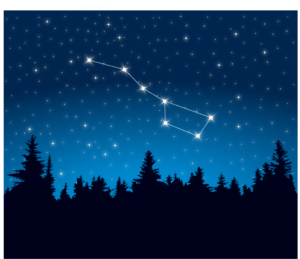
4th of July Patterns
Picture walk through pages 2-17 of Celebrate Fourth of July with Champ, the Scamp. Point out red, white, and blue items with stars and stripes (clothing, blanket, backpack, tablecloth). Ask: Do any of these items have patterns? How do you know? Invite your child to make a pattern with a red, blue, and white crayon on black paper.
1, 2, 3 I’m Willing!
Ask your child if she is willing to practice S.T.A.R. breathing when things aren’t going her way. Say: If you are willing, on the count of three, say, “I’m willing!” 1, 2, 3…I’m willing!
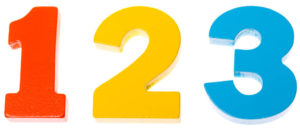
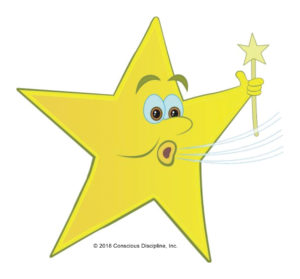
Daily Message
My scrapbook tells about fun adventures!
- As you say the sentence, draw one line on paper for each word. Make the line long for a long word and short for a short word.
- Write a word on each line as your child repeats the sentence. Compare the length of two words.
- Have your child notice and name the exclamation point at the end.
Letter Writing
Focus Letters: Jj, Kk, Ll
Review how to write the letters. Have your child watch as you write a letter saying the strokes. Have your child write the letter with a finger on the floor repeating the strokes. Then have your child practice writing on paper. Repeat for each letter. Click image for letter formation directions.
Travelin’
Pretend to steer your car along as you watch the video and sing along to “Travelin.” Have your child tell about a road trip she remembers taking. Say: Were you caught in a traffic jam? How did it feel? How did you keep yourself calm?
Storytime
Remind your child that My Adventures is about a scrapbook. Look through the book pointing to favorite photos and reading captions. Explain that a caption gives information about the photo beside it. Ask: If you could only go to one of the destinations in this story, which one would you choose? Why?
5-Star Adventure
With your child, write a list of the adventures you have read about this week (amusement park, beach, museum, picnic, zoo). Have your child give the adventures a star-rating to tell how much she liked the adventure. Five stars represents the best adventure. Help your child draw stars (or plus signs) beside each adventure on the list.

Family Adventure
Post the charts you made this week that show where family members would like to have an adventure. Look at all the questions and talk about them. Ask: Would we rather go somewhere loud or quiet? Indoors or outdoors? Far or close to home? At night, during the day or both? Think of some destinations that would meet all the criteria.

Are We There Yet?
Sing “Are We There Yet?” with your child. Help your child think of ideas for games to do in the car when your family takes a long car ride. You might play “I Spy.” You might count the number of trucks you pass. Practice doing the games when you go out to run errands or to the store. Click image for lyrics.
Pack a Picnic
Help your child plan and pack a basket or bag with an outdoor snack. Spread a blanket, unpack the basket, and enjoy the snack together. You are having a picnic! Talk about why a picnic is a special adventure.



